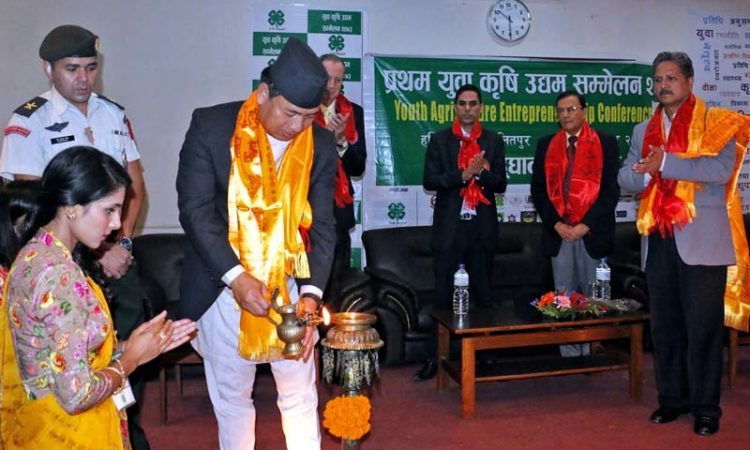
July 8, 2016
| The average age of the farmer all over the world has been found increasing especially in the recent years. This is happening because agriculture is not the first choice of most youths. Not only is the percentage of people engaged in farming decreasing but there has also been a considerable decrease in budget allocation and investment by the state in agriculture. |
Rural exodus
Data show that the average age of farmers in South Korea and Japan already exceeds 60, and even in many developing countries like Nepal, there is an exodus of rural youths to the cities, creating a shortage of manpower to even carry the sick to hospital or dead bodies to the ghats. There are only women, children and elderly people in many villages whereas the youth are either in the towns or in foreign countries in search of employment and opportunities for study. Among others, one of the reasons behind the rural exodus is the distraction of youths from agriculture as the image of the farmer is less than attractive.
Both the evolutionary trend and modern development paradigm suggest that urbanisation, industrialisation, mechanisation and technological development are the bases or indicators of progress and development. That’s why rural migration and urbanisation, work diversification and reduction in farming families, attraction of young people to new sectors of science, technology, trade and tourism, and decreasing investment in agriculture are expected.
Furthermore, youths, the symbol of change, are always mobile and constitute the most dynamic group in society. That’s why they are more eager to be actors, players, singers, politicians and many more than engage in an occupation considered more of a tradition. It’s also logical that every youth, even though he is born in a village, deserves to live the life of his choice.
While saying so, we don’t seem to be thinking that agriculture is the source of livelihood and food the source of life. Why should we take up farming if the state, decision makers and leaders are not bothered about agriculture? We know that to enjoy all other rights, we need food first of all, which must be grown by someone we call the farmer. But those farmers who do the most praiseworthy work of feeding the world are not respected and live a miserable life.
How can we expect the new generation to be attracted to the field that involves plenty of hard work and yet brings disrespect and great risks? The open market, chemical farming, WTO regime and state negligence have made agriculture to suffer, with farming becoming a job to be done only by multinational companies where small farmers and peasants have no voice.
And it is a sad reality that the world is facing food insecurity, with more than a billion people living in hunger and poverty. With the growing population, there is a need to produce more food. With food prices climbing up, the distribution pattern will be more unjust, affecting the food security of more and more people. The present situation demands that there should be someone taking up these responsibilities at all levels, from global to local. It should be someone who cares and thinks about agriculture’s transformation by involving the young generation.
Many people must be aware that rural villages lack basic services and facilities to support a dignified quality of life. That’s why young girls and boys migrate to find a school and then jobs. Many of their families lack a piece of land to produce enough for their members round the year whereas some others are landless. Those with land also can’t support themselves with rain-fed agriculture sometimes destroyed by pests and other times by floods, landslides and drought.
If we look at the world’s development paradigm and moves by many national and international actors, there is one thing common, that is the constant marginalisation and segregation of agriculture and the peasantry. Some attempts have been made in favour of the farmer, but not enough. The world regime in agriculture benefits more the large multinational corporations and companies investing in agriculture, seeds and pesticides, further destroying the small peasantry-based agriculture. Such farming is lethal from the environmental, social, health and sustainable development perspective.
Increasing investment in the small farmer for integrated rural development, orientation, training and education for the youth in agriculture, ensuring access and control of the youth on land, market, credit, seeds and other resources are necessary to change the image of farming from one that is dirty and difficult to one that is decent and highly income-generating. Furthermore, professionalism, mechanisation and commercialisation of production can change the image of farming. Subsidies, insurance, grants and creation of a conducive environment are equally important to attract the new generation to this important sector.
Paradox
It is a paradox that the world which is facing increasing poverty and hunger along with a crisis in agriculture has not been able to address the problem with concrete plans and programmes. It is good news that a global social movement such as the La via Campesina (International Peasant Movement) and the UN agency, the International Fund for Agriculture Development (IFAD), have initiated work with young farmers. And at the national level, some movements are active to advocate the issue of the youths in agriculture. But still there is lot to do to attract the youth in farming to alleviate poverty and hunger.
By Pramesh Pokharel
The writer is  the Secretary of Youth Peasants’ Federation, Nepal






